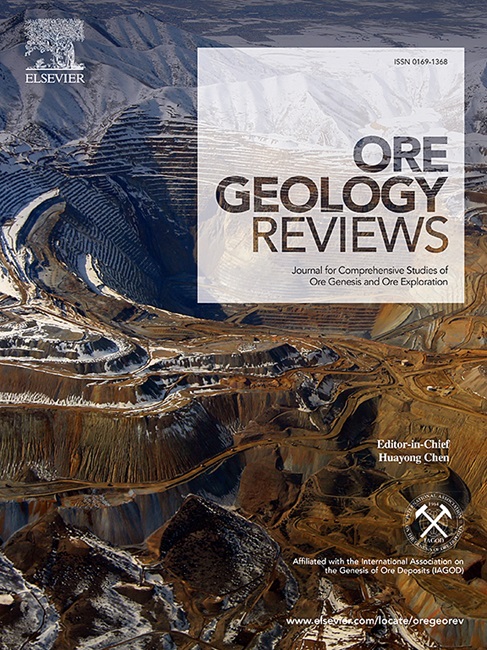Genesis of the Mamuniyeh copper deposit in the central Urumieh-Dokhtar Magmatic Arc, Iran: Constraints from geology, geochemistry, fluid inclusions, and H–O–S isotopes
IF 3.6
2区 地球科学
Q1 GEOLOGY
引用次数: 0
Abstract
The Mamuniyeh Cu deposit is located in the central part of the Urumieh-Dokhtar Magmatic Arc (UDMA), 10 km south of the city of Mamuniyeh, Iran. Mineralization is controlled by faults with a NW-SE trend and hosted within an Eocene volcanic sequence and Oligo-Miocene hypabyssal calc-alkaline monzonitic and gabbroic bodies. Quartz + chalcopyrite veins are most abundant and high-grade ore containing up to 5 wt% Cu, although quartz + pyrite veins have the most abundant sulphide content. In addition, quartz + chalcopyrite + specular hematite ± pyrite veins/veinlets are another common mineralized assemblage in the Mamuniyeh copper deposit, with pyrite, chalcopyrite, bornite, and oxide minerals (specular hematite, titanomagnetite, and magnetite) typical of the hypogene stage. Chalcocite, covellite, and dignite also formed at the margins of primary sulphides in the supergene (paleoweathering) stage. The mineralized veins exhibit colloform, crustiform, open space-fillings, replacements, and dissemination textural characteristics associated with mineralizing assemblages with silicification, argillization, chloritization, and sericitization assemblages. The salinity for L > V fluid inclusions is between 1.74 to 11.7 wt% NaCl and for (V > L) inclusions between 1.7 to 11.4 wt% NaCl. The average homogenization temperature and salinity for quartz + chalcopyrite + pyrite veins is 186 °C and 4.9 wt% NaCl. In the quartz + chalcopyrite assemblage an average of 185 °C and 4.5 wt% NaCl and for quartz + chalcopyrite + specularite ± pyrite (QCSP) an average of 195 °C and 5.59 wt% NaCl was determined. In these three vein types, the fluid density has almost identical values ranging from 0.8 to 1.0 g/cm3. The mineralizing system evolved in two-stages; the first metal precipitation occurred at less than 1 km of crustal depths and second metal deposition stage at shallower crustal levels (less than 500 m). Although it appears that the boiling process occurred within the fluids of the area, the primary factor contributing to Cu mineralization was influenced by fluidmixing processes. The δ18O and δD values of ore fluids computed vary from + 6.08 to −0.50 ‰ and −92 to −71 ‰, respectively, indicative of the blending of oxidizing and cooler meteoric waters with primary magmatic fluids. Calculated values of δ34S of H2S in equilibrium with chalcopyrite ranges from −7.6 to −1.9 ‰ and H2S in equilibrium with pyrite ranges from −7.1 to −3.8 ‰, respectively; this is consistent with monzodiorite to gabbro as the magmatic sulphur source for copper mineralizing fluids. Furthermore, the QCSP vein data align more closely with primary magmatic water compared to other veins, suggesting that precipitation occurred mainly from magmatic fluids, which experienced depletion in δ18O due to mixing with meteoric waters (shallow oxygenated ground waters), which caused sulphide deposition. The geochemical features for these magmas show that contamination with crustal materials occurred during the ascent of the parent magma, as well as the role of suprasubduction fluids released from the subducting plate in mantle metasomatism. Based on all evidence, Cu mineralization in the Mamuniyeh deposit has been categorized as a low-sulphidation epithermal-type system, which formed during active magmatism in the central part of UDMA.

伊朗乌鲁米耶-多赫塔尔岩浆弧中部 Mamuniyeh 铜矿床的成因:来自地质学、地球化学、流体包裹体和 H-O-S 同位素的制约因素
Mamuniyeh 铜矿床位于伊朗 Mamuniyeh 市以南 10 公里处的乌鲁米耶-多赫塔尔岩浆弧(Urumieh-Dokhtar Magmatic Arc,UDMA)中部。矿化受西北-东南走向的断层控制,赋存于始新世火山岩序列和中新世低海拔钙碱性单斜辉长岩和辉长岩体中。石英+黄铜矿脉是最丰富的高品位矿石,含铜量高达 5 wt%,不过石英+黄铁矿脉的硫化物含量也最丰富。此外,石英+黄铜矿+镜赤铁矿±黄铁矿矿脉/细脉是马穆尼耶铜矿床中另一种常见的矿化集合体,黄铁矿、黄铜矿、辉铜矿和氧化物矿物(镜赤铁矿、钛磁铁矿和磁铁矿)是下元古界阶段的典型矿物。在超生(古风化)阶段,原生硫化物的边缘还形成了菱铁矿、鹅卵石和黝帘石。矿化脉表现出胶结状、壳状、空隙充填、置换以及与硅化、芒硝化、绿泥石化和绢云母化等矿化集合体相关的浸染状纹理特征。L > V 流体包裹体的盐度在 1.74 至 11.7 wt% NaCl 之间,(V > L)包裹体的盐度在 1.7 至 11.4 wt% NaCl 之间。石英+黄铜矿+黄铁矿矿脉的平均均化温度和盐度分别为 186 °C 和 4.9 wt% NaCl。石英+黄铜矿矿脉的平均均化温度为 185 ℃,氯化钠含量为 4.5 wt%;石英+黄铜矿+镜铁矿+黄铁矿矿脉(QCSP)的平均均化温度为 195 ℃,氯化钠含量为 5.59 wt%。在这三种矿脉类型中,流体密度值几乎相同,从 0.8 克/立方厘米到 1.0 克/立方厘米不等。成矿系统的演化分为两个阶段:第一个金属沉淀阶段发生在地壳深度小于 1 千米的地方,第二个金属沉积阶段发生在地壳较浅的地方(小于 500 米)。虽然沸腾过程似乎发生在该地区的流体中,但导致铜矿化的主要因素受到流体混合过程的影响。所计算的矿石流体的δ18O 和δD 值分别为 + 6.08 至 -0.50 ‰ 和 -92 至 -71 ‰,表明氧化性和冷却性陨石水与原生岩浆流体的混合。与黄铜矿平衡的 H2S δ34S 计算值范围分别为-7.6 至-1.9‰,与黄铁矿平衡的 H2S 计算值范围分别为-7.1 至-3.8‰;这与单斜辉长岩至辉长岩是铜矿化流体的岩浆硫源是一致的。此外,与其他矿脉相比,QCSP 矿脉的数据与原生岩浆水更为接近,这表明沉淀主要来自岩浆流体,而岩浆流体由于与流星水(浅层含氧地下水)混合,导致δ18O 贫化,从而造成硫化物沉积。这些岩浆的地球化学特征表明,母岩浆在上升过程中受到地壳物质的污染,以及俯冲板块释放的超俯冲流体在地幔变质作用中的作用。根据所有证据,Mamuniyeh 矿床中的铜矿化被归类为低硫表生型系统,是在 UDMA 中部活跃岩浆活动期间形成的。
本文章由计算机程序翻译,如有差异,请以英文原文为准。
求助全文
约1分钟内获得全文
求助全文
来源期刊

Ore Geology Reviews
地学-地质学
CiteScore
6.50
自引率
27.30%
发文量
546
审稿时长
22.9 weeks
期刊介绍:
Ore Geology Reviews aims to familiarize all earth scientists with recent advances in a number of interconnected disciplines related to the study of, and search for, ore deposits. The reviews range from brief to longer contributions, but the journal preferentially publishes manuscripts that fill the niche between the commonly shorter journal articles and the comprehensive book coverages, and thus has a special appeal to many authors and readers.
 求助内容:
求助内容: 应助结果提醒方式:
应助结果提醒方式:


